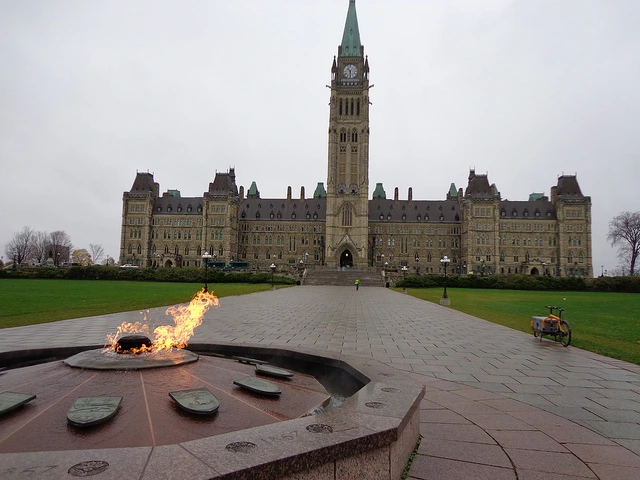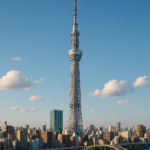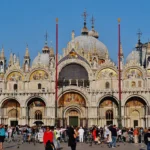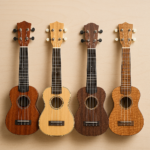
Welcome to our exploration of one of Canada’s most iconic landmarks: Parliament Hill! Nestled in the heart of Ottawa, this stunning site is not only the seat of Canada’s federal government but also a treasure trove of history, architecture, and culture. In this blog, we’ll delve into 25 interesting facts about Parliament Hill that highlight its significance, unique features, and the stories that have shaped it over the years. Whether you’re a history buff, a political enthusiast, or simply curious about this magnificent location, you’re sure to discover something new and fascinating. Let’s embark on this journey through time and uncover the secrets of Parliament Hill!
Location: Parliament Hill is situated in the heart of Ottawa, Ontario, overlooking the Ottawa River. It serves as the political and cultural center of Canada and is a key symbol of Canadian democracy. The site offers stunning views of the surrounding area, including the historic Rideau Canal and the National Gallery of Canada, making it not only a significant political hub but also a popular tourist destination.
Construction Start: The construction of the current Parliament buildings began in 1859, following the decision to move the capital of the Province of Canada from Kingston to Ottawa. The buildings were designed to reflect the aspirations of a young nation and to embody the principles of democracy. The original design was created by architect Thomas Fuller and his partner Chilion Jones, who envisioned a complex that would serve as a fitting home for Canada’s legislative bodies.
Architectural Style: The architectural style of the Parliament buildings is primarily Gothic Revival, characterized by its pointed arches, intricate stone carvings, and tall spires. This style was chosen to convey a sense of grandeur and stability, reflecting the importance of the institutions housed within. The design incorporates elements such as flying buttresses and vaulted ceilings, which are reminiscent of medieval European cathedrals, symbolizing the connection between governance and tradition.
Centre Block: The Centre Block is the main building of Parliament Hill and houses the two chambers of Parliament: the House of Commons and the Senate. It is an iconic structure that features a central tower, known as the Peace Tower, which is a prominent landmark in Ottawa. The Centre Block has undergone significant renovations and restorations, especially after the fire of 1916, ensuring that it remains a functional and symbolic center of Canadian democracy.
Peace Tower: The Peace Tower, standing at 92.2 meters (303 feet), is a striking feature of Parliament Hill and serves as a memorial to Canadians who lost their lives in World War I. The tower houses a carillon that consists of 53 bells, which are played regularly to mark significant events and occasions. The Peace Tower’s observation deck offers panoramic views of Ottawa, making it a popular spot for visitors who wish to appreciate the city’s landscape from above.
Library of Parliament: The Library of Parliament is the only part of the original Parliament Buildings to survive the devastating fire of 1916. This beautifully designed circular building is known for its stunning architecture and extensive collection of books and resources. It serves as a research facility for Members of Parliament and is a vital resource for legislative work. The Library’s design features intricate woodwork and a magnificent dome, making it one of the most beautiful rooms in Canada.
Parliamentary System: Canada operates under a parliamentary democracy, and Parliament Hill is the seat of the federal government. This system allows elected representatives to make laws and govern on behalf of the citizens. Parliament consists of two houses: the elected House of Commons and the appointed Senate. The Prime Minister, who is the head of government, and the Governor General, who represents the monarch, both play key roles in the functioning of Parliament.
Visitors: Parliament Hill attracts approximately 3 million visitors each year, making it one of Canada’s most visited sites. Visitors can explore the historic buildings, attend guided tours, and witness the Changing of the Guard ceremony during the summer months. The site also hosts various cultural events and celebrations, allowing visitors to engage with Canada’s political history and heritage in a meaningful way.
Changing of the Guard: The Changing of the Guard ceremony is a popular attraction that takes place daily during the summer months on Parliament Hill. This ceremonial event features members of the Ceremonial Guard, dressed in traditional red uniforms and bearskin hats, performing a formal handover of duty. The ceremony is steeped in tradition and showcases Canada’s military heritage, drawing large crowds who come to witness this colorful display of pageantry.
Statues: Parliament Hill is home to several statues and monuments that honor important figures in Canadian history, including past Prime Ministers and military leaders. These statues serve as reminders of the individuals who have shaped the nation and its governance. Notable examples include the statue of Sir John A. Macdonald, Canada’s first Prime Minister, and the National War Memorial, which commemorates those who served in the armed forces.
The Senate: The Senate chamber is one of the two houses of Parliament and can seat 105 Senators. Senators are appointed by the Governor General on the advice of the Prime Minister and serve until the age of 75. The Senate plays a crucial role in reviewing legislation passed by the House of Commons, providing a second opinion on proposed laws. The chamber is richly decorated, featuring elegant woodwork and artwork that reflects Canada’s heritage. Senators contribute to the legislative process by conducting studies, holding hearings, and representing regional interests.
House of Commons: The House of Commons is the lower house of Parliament and has 338 elected Members of Parliament (MPs). Each MP represents a specific electoral district, known as a riding, and is elected during federal elections. The House of Commons is where the majority of legislative debates and decision-making occur, and it is characterized by its green benches, symbolizing the democratic nature of the institution. The Speaker of the House is responsible for maintaining order during debates and ensuring that parliamentary rules are followed.
The Confederation: Parliament Hill has been the site of many important events since Canada’s Confederation in 1867, when the British North America Act united the provinces of Ontario, Quebec, New Brunswick, and Nova Scotia into a single Dominion. This historic moment marked the beginning of Canada as a self-governing entity within the British Empire. Over the years, Parliament Hill has hosted numerous significant debates, speeches, and ceremonies that have shaped the nation’s identity and governance, making it a focal point for Canadian history.
Fire of 1916: The Centre Block was destroyed by fire in 1916, which led to the loss of many historical artifacts and documents. The fire started in the early morning hours and quickly engulfed the building, prompting a massive response from firefighters. Following the fire, a reconstruction project was initiated, resulting in the new Centre Block being completed and reopened in 1927. The rebuilt structure retained many of the original architectural elements while incorporating modern safety features, ensuring that it continues to serve as the heart of Canadian democracy.
The Grounds: The grounds of Parliament Hill cover 88.5 acres and are meticulously maintained, featuring beautifully landscaped gardens, pathways, and open spaces. The grounds provide a scenic setting for the Parliament buildings and are often used for public gatherings, demonstrations, and cultural events. Seasonal decorations, such as holiday lights and Canada Day festivities, enhance the beauty of the site. The grounds also include several monuments and memorials that honor Canada’s history and heritage.
Public Access: Parliament Hill is open to the public, allowing Canadians and tourists alike to explore the historic buildings and grounds. Guided tours are available, providing visitors with insights into the workings of Parliament, Canadian history, and the significance of the various architectural features. The accessibility of Parliament Hill encourages civic engagement and fosters a greater understanding of the democratic process, making it a vital educational resource for the public.
Official Residences: The Prime Minister and the Governor General have official residences located near Parliament Hill. The Prime Minister’s residence is 24 Sussex Drive, a historic home that has been the residence of every Prime Minister since Louis St. Laurent. The Governor General resides at Rideau Hall, which is also a historic site and serves as the official residence and workplace for the Governor General. Both residences play important roles in Canadian governance and host numerous official events, ceremonies, and diplomatic functions.
Ceremonial Role: Parliament Hill hosts many national ceremonies, including Canada Day celebrations, Remembrance Day services, and other significant events that reflect Canadian culture and values. These ceremonies often feature speeches by political leaders, performances by artists, and participation from the public, fostering a sense of national unity and pride. The site serves as a gathering place for Canadians to celebrate their identity and commemorate important moments in the country’s history.
The Carillon: The Peace Tower features a carillon with 53 bells, which are played regularly to mark significant events and occasions. The carillon is one of the largest in Canada and produces a rich, resonant sound that can be heard throughout the area surrounding Parliament Hill. The bells were cast in the Netherlands and were installed in the tower as a symbol of peace and remembrance. The carillon is played during special ceremonies and events, adding to the atmosphere of the site and enhancing its historical significance.
Security: The Parliamentary Protective Service is responsible for the security of Parliament Hill, ensuring the safety of the buildings, grounds, and individuals who work there. This service employs a dedicated team of security personnel who monitor access points, conduct patrols, and respond to any incidents. The security measures in place are designed to protect the integrity of Canada’s democratic institutions while allowing public access to the site. The presence of security personnel also helps to maintain a safe environment for visitors and staff, fostering a sense of trust and confidence in the operations of Parliament. The Protective Service collaborates with various law enforcement agencies to ensure comprehensive security protocols are followed, particularly during large public events and gatherings, which can draw significant crowds to Parliament Hill. This commitment to security reflects the importance of safeguarding Canada’s democratic processes and institutions.
Parliamentary Committees: Parliamentary committees play a vital role in the legislative process in Canada. These committees consist of Members of Parliament (MPs) and Senators who meet to study specific issues, review proposed legislation, and conduct inquiries. There are various types of committees, including standing committees, which focus on particular subject areas, and special committees, which are formed for specific tasks. Committees gather evidence, hear from experts and stakeholders, and produce reports that inform Parliament’s decisions. This process enhances transparency and accountability in governance, allowing for more thorough examination of policies and legislation.
Indigenous Presence: Parliament Hill acknowledges the historical and ongoing presence of Indigenous peoples in Canada. Various initiatives and programs aim to recognize and honor Indigenous contributions to the nation. This includes the installation of art and monuments that celebrate Indigenous culture and history, as well as efforts to engage Indigenous leaders in discussions about governance and policy-making. The recognition of Indigenous peoples on Parliament Hill reflects a commitment to reconciliation and understanding, fostering a more inclusive narrative of Canadian history.
Accessibility: Parliament Hill is equipped with facilities and services to ensure accessibility for visitors with disabilities. The site features ramps, elevators, and designated seating areas to accommodate individuals with mobility challenges. Guided tours are also available in formats that cater to different needs, including sign language interpretation. The commitment to accessibility ensures that all Canadians can engage with their democratic institutions, fostering inclusivity and participation in the political process.
Historical Significance: Parliament Hill has been the site of many significant protests, gatherings, and events throughout Canadian history. It has witnessed pivotal moments, such as the suffrage movement, civil rights demonstrations, and national celebrations. The grounds serve as a platform for citizens to express their views and advocate for change, reflecting the democratic values of freedom of speech and assembly. These events contribute to the rich tapestry of Canada’s political landscape and highlight the importance of civic engagement in shaping the nation’s future.
Cultural Events: Various cultural events and festivals take place on the grounds of Parliament Hill throughout the year, celebrating Canada’s diverse heritage. Events such as the Canada Day celebrations feature performances by Canadian artists, fireworks, and activities for families, drawing large crowds and fostering national pride. Additionally, seasonal events, like the Winterlude festival, showcase winter activities and art, while Indigenous cultural events highlight the traditions and contributions of First Nations, Métis, and Inuit peoples. These cultural celebrations enhance the public’s connection to Parliament Hill, making it a vibrant hub for community engagement and national identity.
FAQs about Parliament Hill
1. What is Parliament Hill?
Parliament Hill is the seat of the Parliament of Canada in Ottawa, Ontario. It’s a complex of buildings located on a prominent hill overlooking the Ottawa River. It’s not just a single building, but rather a campus of architecturally significant structures, including the iconic Centre Block, the East Block, and the West Block, as well as several surrounding buildings and grounds. It’s a national symbol of Canada and a popular tourist destination.
2. What buildings are on Parliament Hill?
The most prominent buildings on Parliament Hill are:
- Centre Block: This is the heart of Parliament Hill, housing the Senate Chamber, the House of Commons Chamber, the Library of Parliament, and the Peace Tower. It’s the most recognizable building, with its distinctive Gothic Revival architecture.
- East Block: Located to the east of the Centre Block, this building houses parliamentary offices.
- West Block: Situated to the west of the Centre Block, this building also houses parliamentary offices and committee rooms.
- Library of Parliament: Connected to the Centre Block, this stunning library is known for its beautiful architecture and extensive collection.
- Peace Tower: A prominent bell tower in the Centre Block, it’s a symbol of peace and commemorates Canadians who served in wartime.
3. What is the significance of Parliament Hill?
Parliament Hill holds immense significance for Canada:
- Seat of Government: It’s where the Parliament of Canada, the legislative branch of the federal government, meets and makes laws.
- National Symbol: Parliament Hill is a powerful symbol of Canadian democracy, sovereignty, and national identity. Its image is often used to represent Canada.
- Historical Importance: The site has witnessed many important moments in Canadian history, from Confederation to the present day.
- Architectural Landmark: The Gothic Revival architecture of the buildings is admired worldwide and contributes to the site’s grandeur.
- Tourist Attraction: Parliament Hill attracts millions of visitors each year, who come to learn about Canadian history and government, and to admire the architecture.
4. Can I visit Parliament Hill?
Yes, Parliament Hill is open to the public. Visitors can take guided tours of the Centre Block, including the Senate and House of Commons chambers, and the Library of Parliament. It’s recommended to book tours in advance, especially during peak season. Visitors can also explore the grounds, witness the Changing of the Guard ceremony in the summer, and enjoy the views of the Ottawa River.
5. How do I get to Parliament Hill?
Parliament Hill is located in downtown Ottawa and is easily accessible by various means of transportation:
- Public Transportation: Ottawa’s public transportation system, OC Transpo, has several bus routes that serve Parliament Hill. The nearest O-Train (light rail) station is Parliament Station.
- Car: Parking is available near Parliament Hill, but it can be limited and expensive. It’s advisable to check parking options and rates in advance.
- Walking or Cycling: Parliament Hill is within walking or cycling distance of many downtown Ottawa attractions.
6. What is there to do near Parliament Hill?
Parliament Hill is located in the heart of downtown Ottawa, surrounded by many attractions:
- National War Memorial: Located just east of Parliament Hill, this monument commemorates Canadians who served in wars.
- Rideau Canal: A UNESCO World Heritage Site, the Rideau Canal is a short walk from Parliament Hill and offers boat tours in the summer and skating in the winter.
- National Gallery of Canada: Located near Parliament Hill, this gallery houses an extensive collection of Canadian and international art.
- Canadian Museum of History: Across the river in Gatineau, Quebec, this museum explores Canadian history and culture.
- ByWard Market: A vibrant market area with shops, restaurants, and bars, located a short walk from Parliament Hill.
7. Is there security at Parliament Hill?
Yes, security is taken very seriously at Parliament Hill. Visitors will be required to go through security screening before entering any of the buildings. It’s advisable to arrive early to allow time for security checks.
8. What is the Changing of the Guard ceremony?
The Changing of the Guard ceremony is a popular tourist attraction that takes place on the lawn of Parliament Hill during the summer months. It involves the ceremonial changing of the guards who protect Parliament Hill. It’s a colourful and impressive display of military tradition.
9. When is Parliament in session?
Parliament typically sits for several months of the year, with breaks in between. The exact dates of sittings can vary. Information on the parliamentary calendar can be found on the Parliament of Canada website.
10. Can I attend a parliamentary debate?
Yes, members of the public can attend debates in the House of Commons and the Senate. However, seating is limited and it’s advisable to arrive early. Debates can also be viewed online.








